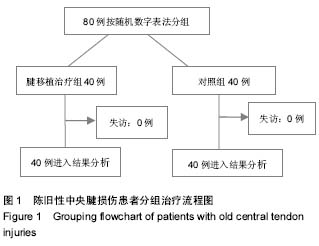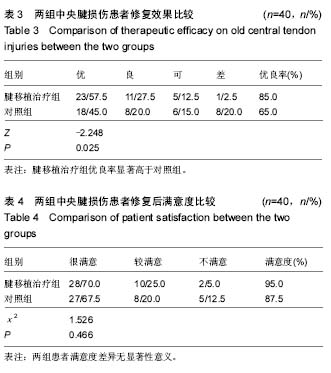| [1] 胡建桥,魏鹏,陈薇薇,等.微型钢板侧方内固定治疗手指近中节指骨骨折的疗效分析[J].现代实用医学,2013,25(6):629-632.
[2] 张恒,王群,金华,等.力学平衡原理治疗陈旧性伸指肌腱中央腱断离[J].基层医学论坛, 2011,15(6):491-494.
[3] 胡俊峰.侧腱束并缝术治疗陈旧性中央腱束断裂损伤的疗效分析[J].齐齐哈尔医学院学报,2012,33(5):613-616.
[4] 叶永奇.陈旧性中央键损伤分期手术疗效分析[D].山西医科大学,临床学院,骨科,2009:1-6.
[5] 吴剑,郑勇,刘艳西.闭合急性与陈旧性跟腱损伤手术重建的中远期疗效[J].实用骨科杂志,2014,20(4):376-379.
[6] 王建然,徐衍祥.侧腱束修复陈旧性中央腱损伤的技术改进[J].中华手外科杂志,2010,14(4):123-126.
[7] Maeda E,Noguchi H,Tohyama H,et al.Biomechanical study of healing of patellar tendon after resection of the central one-third in an adult-mature rabbit model.Biomed Mater Eng. 2013;23(3):173-181.
[8] Xerogeanes JW,Hammond KE,Todd DC.Anatomic landmarks utilized for physeal-sparing, anatomic anterior cruciate ligament reconstruction: an MRI-based study.J Bone Joint Surg Am.2012;94(3):268-276.
[9] Nwafor IA,Eze JC,Aminu MB.Traumatic diaphragmatic rupture through the central tendon with herniation of the stomach and coils of small bowel into the pericardial cavity. Niger J Med.2011;20(4):492-493.
[10] Robert HE,Casin C.Valgus and flexion deformity after reconstruction of the anterior cruciate ligament in a skeletally immature patient.Knee Surg Sports respTraumatol Arthrosc. 2010;18(10):1369-1373.
[11] Kong GM,Gwak HC,Kim JG.A Comparative Study of Surgical Treatment in the Ruptured Achilles Tendon:Minimal incision and Open repair.Korean Foot Ankle Soc.2012;16(3):181-189.
[12] Kearney RS, Achten J, Lamb SE, et al.The Achilles tendon total rupture score: A study ofonsiveness,internal consistency and convergent validity on patients with acute Achilles tendon ruptures. Health Qual Life Outcomes. 2012;10:24..
[13] 叶永奇,梁炳生,田江华.中央腱损伤的治疗进展[J].实用手外科杂志,2008,22(4):223-226.
[14] 赵世伟,邱旭东,赵炳显,等.借助伸腱装置动力结构变化的肌腱移植矫正钮扣状畸形[J].中国组织工程研究与临床康复,2007, 11(8): 1410-1412.
[15] Katarina NH,Karin GS,Roland T,et al.Acute Achilles Tendon Rupture: A Randomized,Controlled Study Comparing Surgical and Nonsurgical Treatments Using Validated Outcome Measures. Am J Sports Med. 2010;38(11): 2186-2193.
[16] 于亚东,郭清,邵新中,等.手指伸肌腱装置的应用解剖学研究[J].河北医药,2002,24(8):616-618.
[17] 杨新明,邹宇纬,刘肃近.侧指间关节掌侧脱位伴指伸肌腱中央腱束和侧副韧带断裂[J].中华手外科杂志,2002,18(2):72-74.
[18] Khan RJ,Fick D,Keogh A,et al.Treatment of acute achilles tendon ruptures. A meta-analysis of randomized controlled trials.J Bone Joint Surg(Am).2005;87(10):2202-2210.
[19] 杨华,周初松.超声诊断近端指间关节伸指肌中央腱断裂的临床研究[J].第一军医大学学报,2012,25(5):556-558.
[20] 毛宾尧,林圣洲.临床骨科手册[M].2版.北京:人民卫生出版社, 2006,675-677.
[21] 刘增兵,张峥嵘,王丽萍,等.改良经骨隧道掌长肌腱腱片移植治疗锤状指畸形[J].中国骨与关节损伤杂志,2014,29(5):512-514.
[22] 刘娟,郑怀远,翁雨雄,等.Mitek微型骨锚钉治疗陈旧性锤状指的疗效分析[J].中国骨与关节损伤杂志,2013,28(1):92-93.
[23] 寿建国,付彪,徐晓汉,等.修薄股前外侧皮瓣联合阔筋膜修复手和足部复合组织缺损[J].中华显微外科杂志,2013,36(3):273-275.
[24] 李占雨,刘 峰,杨 光,等.不同方法重建手指屈指深肌腱止点的生物力学研究[J].中国实验诊断学,2014,18(2):309-310.
[25] 孙景东,刘小涛,谢易,等.自体半腱肌双股重建治疗膝关节内侧副韧带陈旧性损伤疗效观察[J].山东医药,2015,55(1):91-93.
[26] 唐辉,徐永清,杨晓勇,等.改良自体掌长肌肌腱移植治疗陈旧性腱性锤状指[J].临床骨科杂志,2014,17(3):350-361.
[27] 黄俊.皮瓣在手指软组织缺损修复中的应用研究进展[J].安徽医学,2014,35(6):857-859.
[28] 卢启贵,王平,黄东红,等.自体半腱肌转移解剖重建膝内侧副韧带Ⅲ度损伤的临床疗效分析[J].中国骨与关节损伤杂志,2014, 29(1): 94-95.
[29] 官小丽,赵霞,曾化英,等.分期综合性护理对手指屈肌腱损伤患者预后的影响[J].河北医药,2015,37(5): 5789-5791.
[30] 陈捷,魏桂菊,刘桔慧.手指屈肌腱损伤患者的分期综合性护理[J].护理实践与研究,2010,7:53-55.
|



